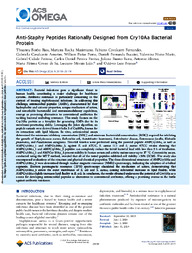Anti-Staphy peptides rationally designed from Cry10Aa bacterial protein.
Anti-Staphy peptides rationally designed from Cry10Aa bacterial protein.
Author(s): RIOS, T. B.; MAXIMIANO, M. R.; FERNANDES, F. C.; AMORIM, G. C.; PORTO, W. F.; BUCCINI, D. F.; MARÍN, V. N.; FEITOSA, G. C.; FREITAS, C. D. P.; BARRA, J. B.; ALONSO, A.; SA, M. F. G. de; LIÃO, L. M.; FRANCO, O. L.
Summary: Bacterial infections pose a significant threat to human health, constituting a major challenge for healthcare systems. Antibiotic resistance is particularly concerning in the context of treating staphylococcal infections. In addressing this challenge, antimicrobial peptides (AMPs), characterized by their hydrophobic and cationic properties, unique mechanism of action, and remarkable bactericidal and immunomodulatory capabilities, emerge as promising alternatives to conventional antibiotics for tackling bacterial multidrug resistance. This study focuses on the Cry10Aa protein as a template for generating AMPs due to its membrane-penetrating ability. Leveraging the Joker algorithm, six peptide variants were derived from ?-helix 3 of Cry10Aa, known for its interaction with lipid bilayers. In vitro, antimicrobial assays determined the minimum inhibitory concentration (MIC) and minimum bactericidal concentration (MBC) required for inhibiting the growth of Staphylococcus aureus, Escherichia coli, Acinetobacter baummanii, Enterobacter cloacae, Enterococcus facallis, Klebsiella pneumonia, and Pseudomonas aeruginosa. Time-kill kinetics were performed using the parental peptide AMPCry10Aa, as well as AMPCry10Aa_1 and AMPCry10Aa_5, against E. coli ATCC, S. aureus 111 and S. aureus ATCC strains showing that AMPCry10Aa_1 and AMPCry10Aa_5 peptides can completely reduce the initial bacterial load with less than 2 h of incubation. AMPCry10Aa_1 and AMPCry 10Aa_5 present stability in human serum and activity maintenance up to 37 °C. Cytotoxicity assays, conducted using the MTT method, revealed that all of the tested peptides exhibited cell viability >50% (IC50). The study also encompassed evaluations of the structure and physical-chemical properties. The three-dimensional structures of AMPCry10Aa and AMPCry10Aa_5 were determined through nuclear magnetic resonance (NMR) spectroscopy, indicating the adoption of ?-helical segments. Electron paramagnetic resonance (EPR) spectroscopy elucidated the mechanism of action, demonstrating that AMPCry10Aa_5 enters the outer membranes of E. coli and S. aureus, causing substantial increases in lipid fluidity, while AMPCry10Aa slightly increases lipid fluidity in E. coli. In conclusion, the results obtained underscore the potential of Cry10Aa as a source for developing antimicrobial peptides as alternatives to conventional antibiotics, offering a promising avenue in the battle against antibiotic resistance.
Publication year: 2024
Types of publication: Journal article
Keywords: Bactéria, Chemical structure, Hydrophobicity, Membranes, Peptides, Proteins
Observation
Some of Embrapa's publications are published as ePub files. To read them, use or download one of the following free software options to your computer or mobile device. Android: Google Play Books; IOS: iBooks; Windows and Linux: Calibre.
Access other publications
Access the Agricultural Research Database (BDPA) to consult Embrapa's full library collection and records.
Visit Embrapa Bookstore to purchase books and other publications sold by Embrapa.

